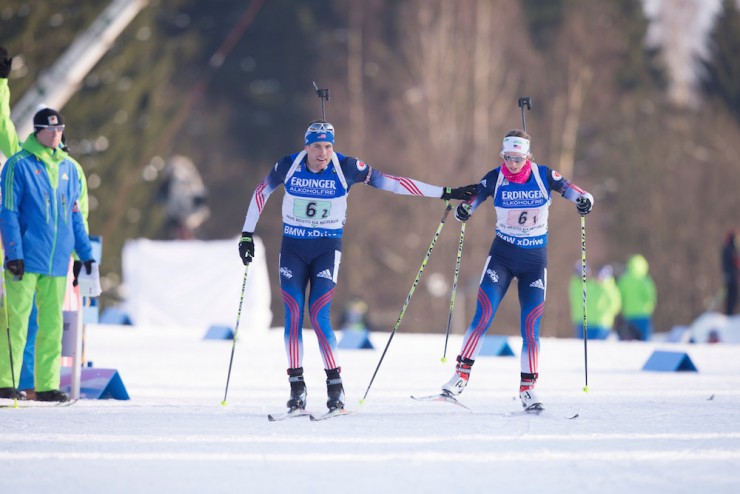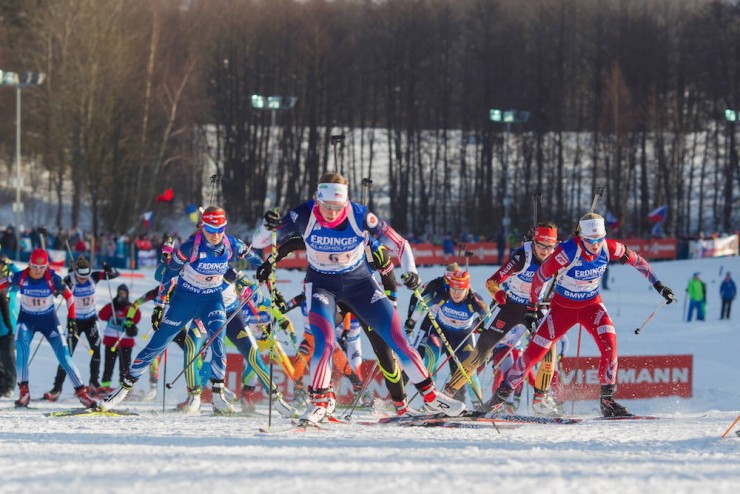
He felt a little weird saying it, but US Biathlon Chief of Sport Bernd Eisenbichler viewed Friday’s single mixed relay — a brand-new event which was first tested in Oslo last season — as a “good training opportunity.”
Between that two-person race and the four-person mixed relay that followed on the same day at the IBU World Cup in Nove Mesto, Czech Republic, there was plenty of racing to go around. Some people needed to get in some intensity after the nearly two-week break from racing.
Each nation entered in both Friday’s single mixed relay and the 2 x 6-kilometer + 2 x 7.5 k mixed relay had to determine a) which six athletes to divvy up among those events and b) the starting order for both. Eisenbichler said on the phone late Friday that the US Biathlon staff decided to pair Annelies Cook and Tim Burke up for the single mixed relay, which is more of a team sprint than any other format, because both needed hard workouts. This way, those two could log intervals on race day.
Meanwhile, Susan Dunklee and Hannah Dreissigacker were put in their “traditional” starting positions of first and second, respectively, in the four-person mixed relay. With Lowell Bailey out sick and recovering in Ruhpolding, Germany, the U.S. opted to start Leif Nordgren as the third leg and 19-year-old Sean Doherty as anchor.
“We see every race as a practice,” Eisenbichler said, pointing to next month’s World Championships in Kontiolahti, Finland, as the end goal. “Every race in their [usual positions] is still a really good experience. It was also, for the boys today, being in the mixed relay in front of 30,000 spectators, a good experience.”
Both races turned out to be something the U.S. was proud of, especially in the four-person mixed relay where the team finished seventh and two-tenths of a second from the flower ceremony. Cook and Burke teamed up for ninth in the single mixed relay (out of 20 teams) despite some shooting struggles.
“I think with two top-10 results we accomplished our Nations Cup points and our goals for the weekend,” Eisenbichler said. “Top eight or top 10 is always what we reach for, I would rather say top eight … and in mixed relay at world championships, I would say top six.”
Single mixed relay

The single mixed relay, in which each male and female on a two-person team races three 1.6 k laps twice, tagging their partner in between, made its debut last year on the same day as a set of men’s and women’s mass starts, which created an even busier day. Dreissigacker and Nordgren raced that event for the U.S., making Cook and Burke total newbies to the format on Friday.
“I was really excited about doing this race today because it was something new and such a fun format,” Cook wrote in an email. “I always loved doing sprints and team sprints in cross-country skiing and this was a little bit like that. I am not sure exactly how the coaches picked the teams for today, but they know I like to sprint and maybe that was part of it.”
Burke explained that he requested to be put in that race because he wanted “to try something different.”
“This format definitely makes for a different race feel,” he wrote in an email after Friday’s race. “It is quite awkward to go from a full sprint into the shooting range. … The ski speed definitely felt faster than any other format.”
Biathlon Canada entered Megan Heinicke and Scott Gow, but Heinicke was too ill to race on Friday so the team did not start the single mixed relay.
“Megan was already showing signs of sickness the day before, that is the reason we put her into the single mix relay otherwise she would have been in the mixed relay,” national team head coach Matthias Ahrens wrote in an email.
For the mixed relay, Canada started Audrey Vaillancourt, followed by Rosanna Crawford, Nathan Smith, and Brendan Green. The four combined for 14th after skiing two penalty loops and using 13 spare rounds.
Between Cook and Burke in the relay earlier that afternoon, the two Americans used 13 spares but avoided penalties, with Cook using three spares on the first shooting stage and Burke using six between two stages on his first leg.
“The first leg was so close to being really good, but I think I was too excited in prone and had random misses,” Cook reflected.
She went on to clean the first stage of her second leg, and used two spares on her last standing.
“Maybe the only difference in my second leg was to just come into the range a little calmer, while still trying to hammer the rest of the course,” she wrote. “It was all a learning experience since I haven’t done anything like this before. Somehow that took the pressure off, but still made it really fun and exciting.”
Burke felt he struggled with the change of pace between sprinting and then suddenly shooting, noting that he was too cautious in the range on his first two stages. The next time around, he used one spare in each shooting stage.
“I adjusted for my second leg and I very happy with how that went,” he wrote. “I think this is an interesting format but it definitely puts a huge emphasis on the shooting.”
The two skied in the top 15 for much of the race, and by the second exchange, they were more than two minutes behind Germany’s Luise Kummer and Erik Lesser in the lead. Cook tagged Burke for the last time in 14th, 2:40.6 back. There, Burke resolved to put them in the top 10.
With the fastest course time of any anchor, he did so, finishing ninth, 2:39.7 behind Russia’s Yana Romanova and Alexey Volkov, who won in 35:43.3.
The Russians took control on the anchor leg after coming through the final exchange in third, 5 seconds behind Germany and 4.8 seconds behind Ukraine. Lesser cleaned prone but missed most of his shots on his final standing stage and had to use three spares and ski three penalty loops.
Volkov cleaned his final shooting to move to first, 26.5 seconds ahead of Ukraine’s Artem Tyschenko in second. Norway’s Henrik L’Abee-Lund used one spare in his final prone and cleaned standing to improve to third overall with one lap to go, less than a second behind Tyschenko. Lesser dropped to fourth, 34.7 seconds back.

On the final lap, Volkov stayed in the clear, looking back near the top of the final rise before the stadium and soon after celebrating with a Captain Morgan-like pose at the finish.
L’Abee-Lund passed Tyschenko to clinch second for Norway (with teammate Marte Olsbu), 21.5 seconds out of first and 3.1 seconds ahead of Ukraine (with Juliya Dzhyma) with in third. A not-so-happy-looking Lesser crossed the line in fourth for Germany, 38.9 seconds back from Russia.
“I always dreamed about taking part in this type of the mixed relay since I saw the test event last season in Oslo,” Romanova told the IBU after the race. “I like it very much and like the short distance where everything depends on shooting!”
Romanova cleaned all four of her stages to put the Russians in third at the last exchange, and Volkov used a total of five spares to secure first place.
“I think that both Tim and I had one bad stage of shooting that hurt our chances for a top result, but I am still happy at the end of the day,” Cook wrote. “I really loved this race format and the only thing I would change is to not have extra rounds as part of it. It would be even crazier with just a short penalty loop.”
Burke agreed.
“I think they should at least do away with the extra rounds, so you spend a little less time on the range,” he wrote after the first-and-only single mixed relay scheduled this season.
Eisenbichler noted that while he’s “not the biggest fan” of the format, “today, it worked out for us. … But for a small team, it’s a really hard stretch to send two teams to the relays,” he added.
On the World Cup circuit, most nations have recently reached the point where they can field competitive teams for the four-person mixed relay, still a relatively new competition itself. Eisenbichler explained that he’d rather see one mixed relay or the other — not both.
“I don’t think it’s just the right format,” he said of the two-person event.
At the same time, the single mixed relay drew tens of thousands of spectators on Friday.
“The idea to do something is interesting …. I think it was a good try,” Eisenbichler said. “I think there will be a decision [after the season] if it goes further on or if there’s a changed format. … It would be really tough to schedule it into world champs in the future.”
Ahrens wrote that he wasn’t the biggest fan of the single mixed relay after last year’s test event, but added Friday that “it could have potential with shorter loops of 1km, no spares to be used and exchange between men and women after each shooting. … The single mixed is more of a shooting race but not so much biathlon with a 50/50 combination.”
Alex Kochon
Alex Kochon (alexkochon@gmail.com) is a former FasterSkier editor and roving reporter who never really lost touch with the nordic scene. A freelance writer, editor, and outdoor-loving mom of two, she lives in northeastern New York and enjoys adventuring in the Adirondacks. She shares her passion for sports and recreation as the co-founder of "Ride On! Mountain Bike Trail Guide" and a sales and content contributor at Curated.com. When she's not skiing or chasing her kids around, Alex assists authors as a production and marketing coordinator for iPub Global Connection.


